March, April and May
All through the winter on mild days the bees bring in the dark orange pollen of the gorse, and the bright orange pollen from the snowdrops and crocuses in February.
The 3rd week in March normally marks the start of a new beekeeping season.
Each colony is inspected - but what to look for, what to expect, and what to do?
Expect to find two frames of brood showing a queen is present and
sufficient frames of stores to support the Spring build up; more to be supplied if necessary.
Find and mark the queen; if a unmarked queen is found when a marked queen was expected then supersedure has taken place.
Occasionally drone brood is found indicating a defective queen; she needs to be found and destroyed - the colony can then be united with another.
Frames with chalk brood or which are otherwise defective need to be replaced.
The photo below shows a lovely frame of new brood seen whilst looking for the queen. Not too many bees are present at this time of the year.
All through the winter on mild days the bees bring in the dark orange pollen of the gorse, and the bright orange pollen from the snowdrops and crocuses in February.
The 3rd week in March normally marks the start of a new beekeeping season.
Each colony is inspected - but what to look for, what to expect, and what to do?
Expect to find two frames of brood showing a queen is present and
sufficient frames of stores to support the Spring build up; more to be supplied if necessary.
Find and mark the queen; if a unmarked queen is found when a marked queen was expected then supersedure has taken place.
Occasionally drone brood is found indicating a defective queen; she needs to be found and destroyed - the colony can then be united with another.
Frames with chalk brood or which are otherwise defective need to be replaced.
The photo below shows a lovely frame of new brood seen whilst looking for the queen. Not too many bees are present at this time of the year.
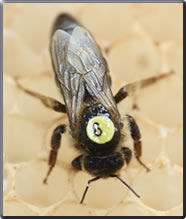
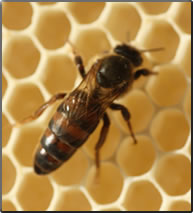
Drone brood
At the first examination a special frame which encourages the bees to make drone brood is put in each colony. This frame ensures that there are plenty of drones produced for queen mating in May. The frame can also be used for monitoring the varroa in the drone brood. The center partition is push-fit for use with a Jenter kit. This drone frame can be left in the hive over the winter when the bees will use it for winter storage.
At the first examination a special frame which encourages the bees to make drone brood is put in each colony. This frame ensures that there are plenty of drones produced for queen mating in May. The frame can also be used for monitoring the varroa in the drone brood. The center partition is push-fit for use with a Jenter kit. This drone frame can be left in the hive over the winter when the bees will use it for winter storage.
Seasons: Spring
Finding the Queen
The main exercise at this time is to find and mark all the queens. This is easier said than done. Unmarked black queens seem to be notoriously difficult to find even in small colonies. I do not have a fail free plan but hope that by following the basic rules and applying lots of patience all the queens can eventually be found and marked. My technique is to start at the back of the hive and work forward to the entrance. It is unlikely that the queen would be on the first few frames which consist of stores at this time of the year, but a more intense scrutiny is started as the middle of the box is reached. If on reaching the final frame there has been no success, then the frames are reexamined in reverse order.
If a queen is not found on the first examination, then the procedure can be repeated a few days later when the search might be more successful.
The main exercise at this time is to find and mark all the queens. This is easier said than done. Unmarked black queens seem to be notoriously difficult to find even in small colonies. I do not have a fail free plan but hope that by following the basic rules and applying lots of patience all the queens can eventually be found and marked. My technique is to start at the back of the hive and work forward to the entrance. It is unlikely that the queen would be on the first few frames which consist of stores at this time of the year, but a more intense scrutiny is started as the middle of the box is reached. If on reaching the final frame there has been no success, then the frames are reexamined in reverse order.
If a queen is not found on the first examination, then the procedure can be repeated a few days later when the search might be more successful.
Monitoring for varroa
In the last week in March a varroa screen is placed under each colony and left for 9 days. If there is a significant varroa drop then the colony is treated with formic acid as described under Varroa 3 in the menu above.
The photo on the left (hive entrance at the top) clearly shows the debris pattern. The brood nest is top right and 10 frames in total are being worked on. The frames towards the back of the hive containing stores are being opened. The colony appears to be in a healthy state and progressing well for the time of the year.
The varroa screen can also be used at the beginning of each month (January, February, March) to check the viability of the colony without opening the hive. If placed underneath for say 10 days the pattern of debris found on the board gives an indication of where the cluster is and the number of frames occupied by the bees.
And also whether a colony has died out as seen in the photo above.
In the last week in March a varroa screen is placed under each colony and left for 9 days. If there is a significant varroa drop then the colony is treated with formic acid as described under Varroa 3 in the menu above.
The photo on the left (hive entrance at the top) clearly shows the debris pattern. The brood nest is top right and 10 frames in total are being worked on. The frames towards the back of the hive containing stores are being opened. The colony appears to be in a healthy state and progressing well for the time of the year.
The varroa screen can also be used at the beginning of each month (January, February, March) to check the viability of the colony without opening the hive. If placed underneath for say 10 days the pattern of debris found on the board gives an indication of where the cluster is and the number of frames occupied by the bees.
And also whether a colony has died out as seen in the photo above.
Pollen and play flights
On mild days the bees are extremely busy with copious amounts of dark brown (gorse) and yellow (pussy willow) pollen seen, with new bees emerging on their play flights in the late morning - the warmest time of the day.
It is an interesting exercise to ask if it might be possible to correlate the pollen count (i.e. the number of pollen packets coming into the hive per minute) to the health and progress of the colony, and in fact if the colony is 'queen-right' . Especially at this stage of the season when the colony has not yet been inspected.
The bar chart above represents a count taken on a sunny day in mid March (T = 9 ℃) when the bees were very busy. When the colonies were examined a week later, again on a mild day, a direct correlation was found between the pollen count and the strength of the colony. Those with pollen counts of 5 and above could be considered to be 'strong' with 2 or 3 frames of well developed brood. Those with a count of 2.5 and lower were considered to be 'weak' with only 1 or 2 small patches of sealed brood. (Only colony 10 was found to be queenless). Although all colonies still had plenty of the winter stores available, the results would suggest that more attention should be given to the weaker colonies with a view to eventually culling the weakest. The results might also point to those 'strong' colonies which might provide the queen mothers for this year's breeding program. And the colonies which will be encouraged to provided plenty of drone brood.
Supers
After the treatment for varroa (if necessary) two supers are normally put on each colony in mid April in readiness for the flowering of the dandelion - the first major source of nectar after the winter. The supers are left wet after the extraction of the honey in August and are now readily cleaned up and worked on by the bees.
On mild days the bees are extremely busy with copious amounts of dark brown (gorse) and yellow (pussy willow) pollen seen, with new bees emerging on their play flights in the late morning - the warmest time of the day.
It is an interesting exercise to ask if it might be possible to correlate the pollen count (i.e. the number of pollen packets coming into the hive per minute) to the health and progress of the colony, and in fact if the colony is 'queen-right' . Especially at this stage of the season when the colony has not yet been inspected.
The bar chart above represents a count taken on a sunny day in mid March (T = 9 ℃) when the bees were very busy. When the colonies were examined a week later, again on a mild day, a direct correlation was found between the pollen count and the strength of the colony. Those with pollen counts of 5 and above could be considered to be 'strong' with 2 or 3 frames of well developed brood. Those with a count of 2.5 and lower were considered to be 'weak' with only 1 or 2 small patches of sealed brood. (Only colony 10 was found to be queenless). Although all colonies still had plenty of the winter stores available, the results would suggest that more attention should be given to the weaker colonies with a view to eventually culling the weakest. The results might also point to those 'strong' colonies which might provide the queen mothers for this year's breeding program. And the colonies which will be encouraged to provided plenty of drone brood.
Supers
After the treatment for varroa (if necessary) two supers are normally put on each colony in mid April in readiness for the flowering of the dandelion - the first major source of nectar after the winter. The supers are left wet after the extraction of the honey in August and are now readily cleaned up and worked on by the bees.
Winter stores and possible Spring feeding
The beginning of March is a critical time for the colony. The queen will have started to produce the first brood. The winter stores are being used up to feed the new brood. If there are not sufficient stores then the colony reaches this crucial point which could result in starvation. It could prove prudent of offer the colony a syrup feed provided the ambient temperature is 9° or above. A syrup made by dissolving 2 kg sugar in 1.5 L hot water and offered in an inverted jar feeder from the hole in the crown board will be readily accepted by the bees. This concentration (57% w/w) is more dilute than that given for winter feeding (62% w/w) but is more akin to the concentration which the bees find in nectar.
(The concentration is equivalent to 5 lb sugar dissolved in 3 pints water).
Alternatively fondant can be placed over the feed hole in the crown board.
The beginning of March is a critical time for the colony. The queen will have started to produce the first brood. The winter stores are being used up to feed the new brood. If there are not sufficient stores then the colony reaches this crucial point which could result in starvation. It could prove prudent of offer the colony a syrup feed provided the ambient temperature is 9° or above. A syrup made by dissolving 2 kg sugar in 1.5 L hot water and offered in an inverted jar feeder from the hole in the crown board will be readily accepted by the bees. This concentration (57% w/w) is more dilute than that given for winter feeding (62% w/w) but is more akin to the concentration which the bees find in nectar.
(The concentration is equivalent to 5 lb sugar dissolved in 3 pints water).
Alternatively fondant can be placed over the feed hole in the crown board.
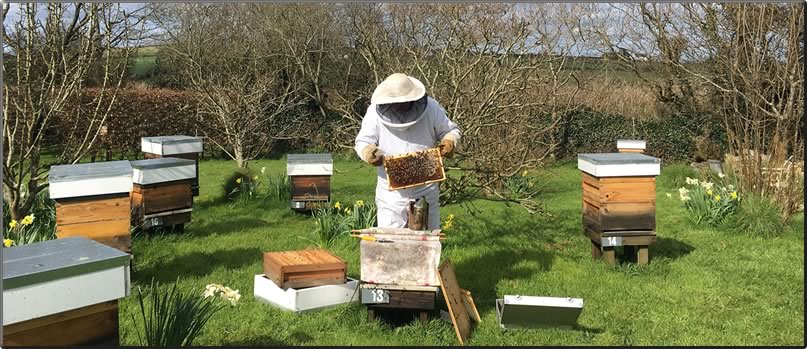
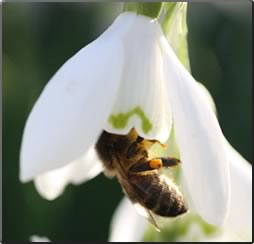
Above: a black bee collecting the bright orange pollen from snowdrops in mid February and
Below: a black bee on C. tomasinianus
Below: a black bee on C. tomasinianus
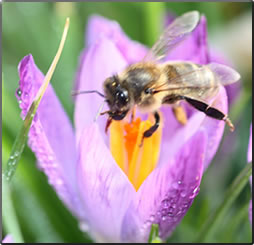
Strange that the colour of a 'black' queen can vary. Most of mine are black with no banding as shown on the left, but the occasional queen is seen which is ginger with strong orange banding (on the right).
Any successful manipulation for swarm control later in the season depends almost entirely on the beekeeper's ability to find the queen.
On finding a queen, I now use a queen marking kit fixing a colour coded numbered plastic disc to her thorax.
Any successful manipulation for swarm control later in the season depends almost entirely on the beekeeper's ability to find the queen.
On finding a queen, I now use a queen marking kit fixing a colour coded numbered plastic disc to her thorax.
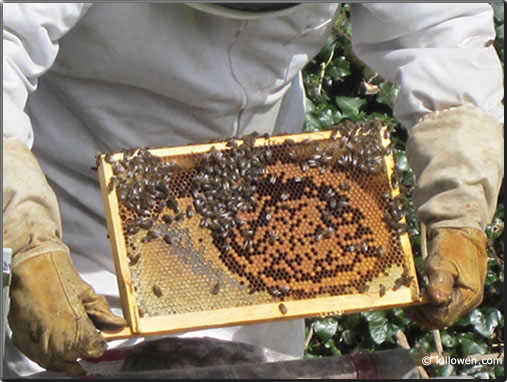
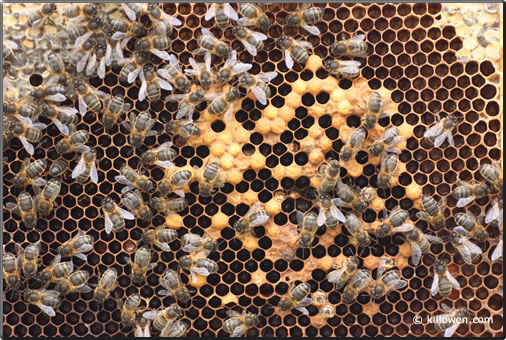
Drone-breeder queen
During the first spring examination some untidy drone brood might be found as shown in the photo.
In this particular colony drone brood was found on two frames. Such brood indicates that the queen is too old and is failing.
She might also be a young queen following supersedure in late summer but was inadequately mated perhaps because of poor weather.
The best solution is to find and destroy the queen, and then unite the colony with another of similar strength so making use of the bees in the spring build up.
During the first spring examination some untidy drone brood might be found as shown in the photo.
In this particular colony drone brood was found on two frames. Such brood indicates that the queen is too old and is failing.
She might also be a young queen following supersedure in late summer but was inadequately mated perhaps because of poor weather.
The best solution is to find and destroy the queen, and then unite the colony with another of similar strength so making use of the bees in the spring build up.
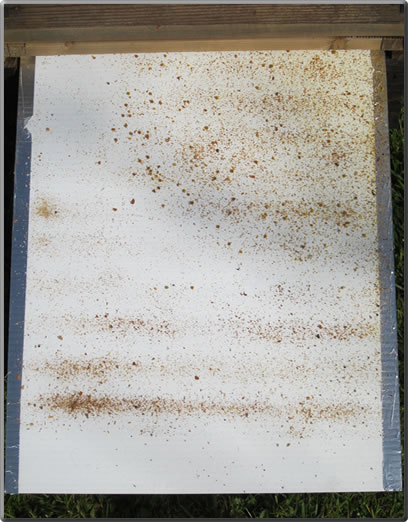


A colony dies out
Very occasionally a sad scene is met with. The bees are clustered around the queen but are quite dead. Sometimes it is difficult to understand why the bees appear to have died from starvation when there is sufficient food available close by. Perhaps the queen was reluctant to move across the frame in the cold weather.
Perhaps it is just a case of survival of the fittest.
In this particular case the colony was active at the beginning of February as monitored by the debris drop (see below), but had died out at the beginning of March. The weather in between was very cold with an especially freezing week when the temperature dropped to -5 °C.
There was no brood in the frame which was perhaps surprising as a little might have been expected at this time of the year.
Very occasionally a sad scene is met with. The bees are clustered around the queen but are quite dead. Sometimes it is difficult to understand why the bees appear to have died from starvation when there is sufficient food available close by. Perhaps the queen was reluctant to move across the frame in the cold weather.
Perhaps it is just a case of survival of the fittest.
In this particular case the colony was active at the beginning of February as monitored by the debris drop (see below), but had died out at the beginning of March. The weather in between was very cold with an especially freezing week when the temperature dropped to -5 °C.
There was no brood in the frame which was perhaps surprising as a little might have been expected at this time of the year.

Fish glue is the preferred adhesive. A natural glue that has been used since antiquity; for example for binding parchments. As used as described above fish glue gives a very strong bond and it appears the bees do not detect any odour.
Over time the glue tends to thicken but adding a little water and stirring brings back the right constituency.
Click for a supplier
Over time the glue tends to thicken but adding a little water and stirring brings back the right constituency.
Click for a supplier